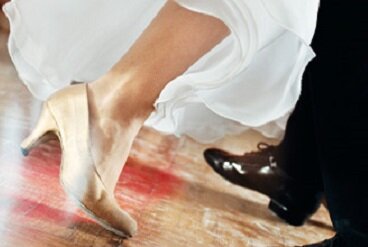Why the Three Step is Counted
"QQS" 
28 February 2017
Many dancers learn the Foxtrot Three Step counted SQQ, but if you look in a technique book, you will probably find something else. In fact, the Three Step is often said to start with the Man's RF forward, and to be counted QQS. To find the answer to this controversy, we must learn a bit about the history of Foxtrot, and think about it in a completely different way.
The Original Three Step
Victor Silvester was the first World Champion in Ballroom, and also the first to describe the Foxtrot in a book. In his 1932 publication Theory and Technique of Ballroom Dancing, he stated that the basic Foxtrot was comprised only of two components: the Walk and the Three Step. At this point, a three step is comprised of three steps danced forward or back, counted QQS. In fact, according to Silvester, the Feather Step is comprised of a RF Walk and then a Three Step, counted S (Walk) QQS (Three Step).
Let us apply Silvester's way of thinking to a string of Feather Steps and Three Steps. You may be inclined to count them as follows:
| Feather Step | SQQ | |
| Three Step | SQQ | |
| Feather Step | SQQ | |
| Three Step | SQQ |
But Silvester would see the underlying pattern as being this:
| RF Walk | S | |
| LF Three Step | QQS | |
| RF Three Step | QQS | |
| LF Three Step | QQS | |
| RF Three Step | QQS |
The extra Slow at the end becomes the first step of the following Feather Step.
Now let's look at a more complicated amalgamation. You may be inclined to think of it as follows:
| Feather Step | SQQ | |
| Reverse Turn | SQQ | |
| Feather Finish | SQQ | |
| Three Step | SQQ |
But Silvester would see the underlying pattern as being this:
| RF Walk | S | |
| LF Three Step Forward, turning on the Slow to end backing LOD | QQS | |
| RF Three Step Backward, turning after the Slow to commence the next step pointing DW | QQS | |
| LF Three Step Forward | QQS | |
| RF Three Step Forward | QQS |
Again, the extra Slow at the end becomes the first step of the following Feather Step or Natural Turn.
There are two problems with this underlying picture. Firstly, the underlying Three Step crosses over multiple figures. For example, in the first Three Step, the QQ is part of the Feather Step, while the S is part of the Reverse Turn. Secondly, a single three step does not fit into a single bar of music. Because of these problems, many have thought it easier to think about Foxtrot in a different way, necessitating a redefinition of what the Three Step actually is.
New Method
Today, many dancers learn the Feather Step as SQQ, which means the Reverse Turn will start right afterward. Likewise, they learn the Three Step as SQQ, meaning the Natural turn will start right afterward. This is the way it is described in the new WDSF technique books: there is no blending of steps between figures, and the borders of each figure are black and white. This new evolution loses a lot of the history and underlying reasoning that made Foxtrot what it is today, however, it is a lot easier to learn. Nevertheless, one criticism of abandoning the old way of thinking of Foxtrot is that the new way ends Feathers OP, which fails to teach students the proper way to take the following step, resulting in a state of unbalance, and clunkiness during the Three Step.
Almost all technique books maintain the old way of describing Foxtrot, which is why if you look up the Three Step on Ballroom Guide, you will find it described as QQS. Unlike in the days of Victor Silvester, today there is only one Three Step, and most would not find variations of it all throughout Foxtrot. It has been relegated to a single figure, whose sole purpose is to link a Feather to a Natural Figure, but hopefully learning about the history can give you a new appreciation for one of the most complex dances in Ballroom.